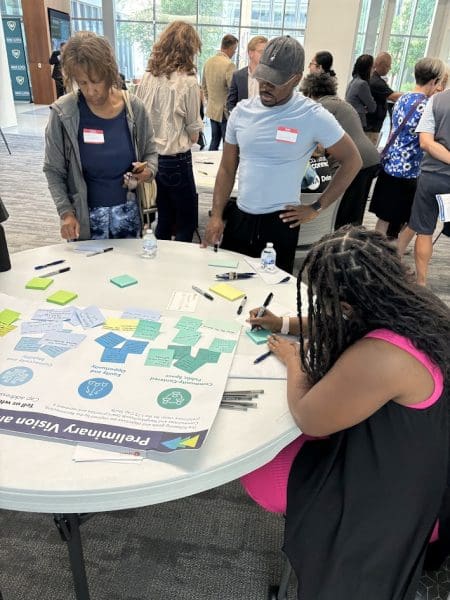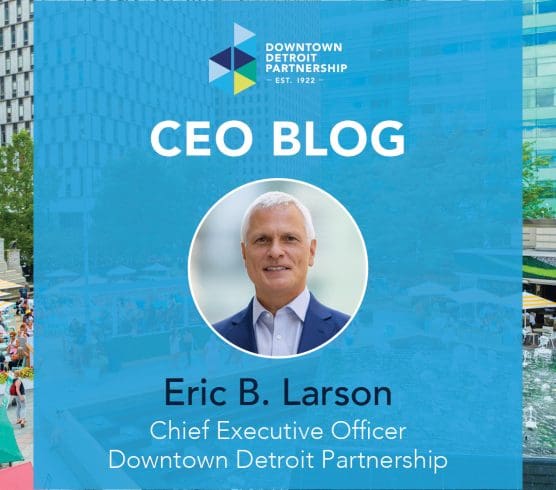When discussing urban planning for Downtown Detroit’s future—or that of any major city—key themes generally rise to the top: vision, leadership, infrastructure, investment, development, placemaking.
All of these are critically important, but whatever your area of expertise or idea about the future of downtowns, there is always one common denominator: DATA. Data informs the transition of downtowns and guides their progress. The Downtown Detroit Partnership proactively tracks data that is critically important as we continue to move from a Central Business District to a Central Connectivity District. Transforming downtowns from CBDs to CCDs or 24/7/365 environments involves understanding multiple factors. How many workers are heading to the city, how are they getting there, and what route do they take? Are those workers heading into empty buildings? From daily visits to our award-winning parks to monthly office rates to annual population shifts, every piece of data tells a story that ultimately helps us create a road map for the future.
If you have never considered what’s involved, here’s a short (!) list of key data points that help us inform this transformation:
Demographics:
- Population growth and density
- Age distribution
- Household sizes and types
- Income levels and employment rates
Commercial and Residential Real Estate Trends:
- Office space vacancy rates
- Rental and property prices
- Mixed-use development statistics
- Residential housing availability and occupancy rates
Economic Indicators:
- Local business growth and diversity
- Retail and hospitality industry performance
- Job creation and unemployment rates
- Investment levels and sources
Transportation and Mobility:
- Public transit usage and coverage
- Walkability and bike-friendliness scores
- Traffic patterns and congestion levels
- Availability of ride-sharing and micro-mobility options
Technology and Connectivity:
- Broadband and wireless internet availability
- Adoption rates of smart city technologies
- Digital infrastructure investments
- Integration of IoT devices and systems
Public Spaces and Amenities:
- Parks, green spaces, and recreational facilities
- Cultural and entertainment venues
- Dining and retail options
- Public safety and cleanliness
Community Engagement and Social Infrastructure:
- Levels of civic participation and community events
- Availability of social services and community centers
- Educational institutions and resources
- Health-care facilities and access
Environmental Sustainability:
- Energy consumption and efficiency
- Waste management and recycling programs
- Air and water quality measures
- Green building initiatives and certifications
Policy and Governance:
- Urban planning and zoning regulations
- Incentives for development and redevelopment
- Public-private partnerships
- Long-term strategic plans and vision statements
Tourism and Visitor Data:
- Number of tourists and visitors
- Hotel occupancy rates
- Major events and conventions hosted
- Tourist spending patterns
You can see that a snapshot of each forms a comprehensive view of the factors driving the evolution of Downtown Detroit and what the DDP team and urban planners, policymakers, and developers worldwide use to make informed decisions in urban innovation, strategic placemaking, and programming.
We also know that data comes in forms beyond numbers. There is incredible value in hard data, such as those listed above, and “soft” data. This includes community input, visitor impressions, and citizen expectations. That’s why the DDP works hard to engage community members in numerous ways, including holding visioning sessions and survey on the future of I-75, conducting the biennial Downtown Detroit Perceptions Survey, and gathering data during the NFL Draft to understand how large-scale events create social and economic impact in Downtown Detroit.
The DDP is constantly enhancing our data-generating capabilities and working with other organizations to capture data for our road map. Each piece of data makes our team wiser, more focused, and more committed to creating a vibrant, safe, and welcoming Downtown with a clear path forward.
Our ability for sustainable growth is dependent on not just collecting data but proactively adjusting and innovating based on such data. Our partners and stakeholders all use data to inform their decisions and DDP uses data to inform ours — for the future.

